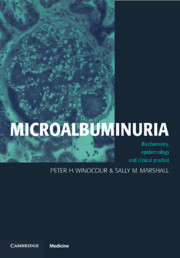Book contents
- Frontmatter
- Contents
- Preface
- Foreword by Professor K. G. M. M. Alberti
- 1 Renal structure and physiology
- 2 Measurement and expression of microalbuminuria
- 3 Epidemiology and determinants of microalbuminuria in health
- 4 Microalbuminuria in diabetes mellitus
- 5 Microalbuminuria as a marker of endothelial dysfunction
- 6 Microalbuminuria, cardiovascular risk factors and cardiovascular disease
- 7 Microalbuminuria as a non-specific marker of disease
- 8 The management of microalbuminuria in diabetes mellitus and essential hypertension
- Index
8 - The management of microalbuminuria in diabetes mellitus and essential hypertension
Published online by Cambridge University Press: 06 July 2010
- Frontmatter
- Contents
- Preface
- Foreword by Professor K. G. M. M. Alberti
- 1 Renal structure and physiology
- 2 Measurement and expression of microalbuminuria
- 3 Epidemiology and determinants of microalbuminuria in health
- 4 Microalbuminuria in diabetes mellitus
- 5 Microalbuminuria as a marker of endothelial dysfunction
- 6 Microalbuminuria, cardiovascular risk factors and cardiovascular disease
- 7 Microalbuminuria as a non-specific marker of disease
- 8 The management of microalbuminuria in diabetes mellitus and essential hypertension
- Index
Summary
DIABETES MELLITUS
Introduction
As discussed in previous chapters, the presence of persistent microalbuminuria in insulin-dependent diabetic patients identifies a subgroup who will eventually progress to end-stage renal failure and who are at high risk of vascular disease. In non-insulin-dependent diabetes, the majority of patients with microalbuminuria will succumb prematurely to vascular disease, the minority who survive for long enough being at risk of progression to endstage renal disease or cancer-related deaths. Thus microalbuminuria encompasses a spectrum of risk, the balance in insulin-dependent diabetes being towards renal disease and in non-insulin-dependent diabetes, as in the general population, to large vessel disease. The management of diabetic patients with microalbuminuria therefore has two main aspects: the reduction in the risk of nephropathy, which is of major importance in insulin-dependent diabetes, and the reduction in cardiovascular risk, which has predominance in non-insulin-dependent diabetes. In practice, both aspects are obviously interconnected, as measures to reduce renal risk may also reduce the risk of large vessel disease and vice versa.
Consideration of the features associated with microalbuminuria, as described in Chapter 4, and of the pathophysiological changes in diabetic nephropathy leads to a number of obvious therapeutic avenues worthy of exploration (Table 8.1). In dealing with the cardiovascular risk, in the absence of controlled trials specifically in diabetes, the assumption is made that measures which reduce the risk in the non-diabetic population will also be effective in people with diabetes.
- Type
- Chapter
- Information
- MicroalbuminuriaBiochemistry, Epidemiology and Clinical Practice, pp. 191 - 244Publisher: Cambridge University PressPrint publication year: 1998



